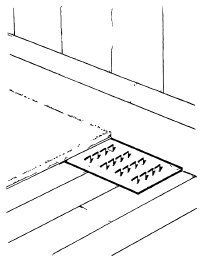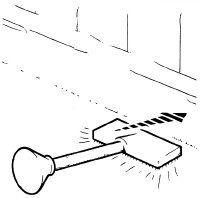When all the fastener strips have been nailed into place, you are ready to start installing the carpet. Take the rolled-up carpeting and pull it into position in the room. Then unroll it, right over the bare floor. This is so you won't jerk the padding out of place later by pulling the carpeting across it. Roll the carpeting back from one side toward the center of the room, exposing the floor again.
Unroll a strip of foam padding along the edge of the floor across the bare side of the room from wall to wall, waffle-patterned side up. Cut the strip carefully with heavy scissors, leaving about 2 inches overlapping the fastening strips at each end. Pull the strip to position it over the bare end of the floor so that it overlaps the fastening strips on both ends and along the wall. Then staple it into place, using a staple gun to set staples diagonally every 6 inches or so along all four edges of the padding.
Cover the rest of the room the same way, rolling the carpeting back so you can roll the padding into place. Butt the edges of the strips of padding and staple every 6 inches along every edge. Trim the padding as necessary to fit around obstacles, cutting as closely as possible around them.
On concrete floors, use carpet padding adhesive to anchor the foam padding. Position the padding as described previously and roll it back from one side, then spread adhesive on the exposed floor as directed, using a paintbrush or a fine-toothed notched trowel. Roll the padding out onto the adhesive, pressing and smoothing it into place. To complete the gluing, roll the padding back from the other wall, apply the adhesive, and unroll the padding. Repeat, butting the strips of padding, until the entire floor is padded. Fill in under radiators with small pieces of padding.
When all the padding has been set into position, trim off the edges overlapping the fastening strips. Use a utility knife with a sharp heavy-duty blade to trim the excess padding: Holding the knife at an angle toward you, cut the padding off exactly where it meets the inside edge of the fastening strips. The surface of the padding should be more or less level with the surface of the fastening strips.
Finally, unroll the carpeting over the padding and pull it carefully into position, overlapping the fastening strips all around the room. Slit the folded-up carpeting vertically where it goes around corners, being careful not to cut past the overlap into the main carpet, so that the edges lie flat against both corner walls. Make straight cuts and crosscuts to fit the carpeting around radiators and other obstructions; don't cut holes in the carpet to accommodate them. Trim carefully around open floor registers, leaving a slight overlap.
Attach the carpeting to the fastening strips with the knee kicker. Starting in a corner, set the head of the kicker flat on the carpet, about an inch from the wall and aimed slightly down and at an angle to the wall. Kneeling on the floor at the corner, hold the handle of the kicker with one hand and lean on the floor with the other. Put all your weight on the knee opposite the arm holding the kicker and move your other knee forward sharply to hit the cushioned end of the kicker. The head of the kicker will stretch the carpeting under it to hook it onto the teeth of the fastening strip at the edge of the floor, leaving an untrimmed edge of carpeting still sticking up against the wall. Repeat the kicking process to fasten the carpeting on the opposite wall of the corner.
After kicking the first corner of the room into place, fasten the two adjacent corners the same way, leaving the diagonally opposite corner loose. Then work from your starting corner out along the two walls of the corner, holding the just-fastened carpeting in place with one hand and using the other to kick the next few inches of carpeting. Make sure the carpeting lies flat and doesn't shift as you work. Fasten the third side of the carpet, working toward the loose corner, and then fasten the fourth side.
Use a utility knife with a sharp heavy-duty blade to trim the edges of the carpeting, and replace the blade as soon as it begins to dull. Cut off the turned-up edge of carpeting evenly, leaving about 3/8 inch still sticking up above the tacked-down edge. Cut carefully, and snip off any ragged tufts of yarn.
To complete the installation, use a stiff putty knife to wedge the trimmed edge of the carpeting down into the 1/4-inch gap between the walls and the fastening strips. Press the cut edge of the carpeting firmly into place all around the room. To finish the edge at doorways, trim the carpet edge carefully to fit under the curved rim of the door finishing strip. Push the raw carpet edge under the rim and use a hammer and a wood block to pound the rim firmly down over the carpet edge.
Finally, replace floor registers -- you may have to trim the carpet edge back farther, but cut carefully. Replace quarter-round baseboard molding if you removed it earlier, and rehang the doors. If the new carpeting and padding are much thicker than the old floor covering, you'll probably have to plane the bottom edge of each door so it can open and close easily. Remove the door from its hinges and plane the bottom edge carefully, planing from both ends toward the center. Rehang the door. Move the furniture back into the room. Enjoy your new carpet!
For more information related to carpet installation:

